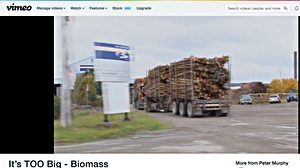 Antigonish filmmaker Peter Murphy and a group of four ACALA volunteers re-released what might be described as “the Nova Scotia version of Burned” on Vimeo a few days ago: It’s TOO Big – Biomass, 8 min 54 secs, with local footage, interviews with Danny George, Bob Bancroft.
Antigonish filmmaker Peter Murphy and a group of four ACALA volunteers re-released what might be described as “the Nova Scotia version of Burned” on Vimeo a few days ago: It’s TOO Big – Biomass, 8 min 54 secs, with local footage, interviews with Danny George, Bob Bancroft.
“The assignment was to create a short film in 3 weeks…we decided to do something on our local biomass plant in Point Tupper”.
They did indeed.
It may seem stark, one-sided.. but the basic issues were identified in 2009/2010 before it all began and Nova Scotians and their landscapes and wildlife have paid a huge price for ignoring them (not to mention that it is subsidized energy).
We have yet to see a full public accounting from Port Hawkesbury Paper/NS Power for the feedstocks going into the Pt. Tupper Biomass Boiler, a lot of it from FSC-certified Crown lands or of the net GHG balance for this operation.
Nor has the forest nutrient-budget model – which was developed initially by NSDNR to examine possible effects of forest biomass harvesting on soil nutrients and soil acidification – been implemented, even in a precautionary way.
Should the promoters and regulators who have willfully ignored the calls for accountability that once came from a few and could be ignored, now be surprised that they come from far and wide?
The video was “uploaded 3 years ago” (Vimeo) on the Seabright channel receiving 28.6k plays; the “re-release” is on Peter Murphys Vimeo channel, I assume, as a contribution to the discussions going on as the film “Burned” – about biomass burning in the U.S. – is shown around NS. Burned was released in 2018.
A tip of the hat to BW/Annapolis Royal & Area – Environment & Ecology
ADDENDUM Jan 26, 2019:
Danny George on getting value from your wood
3 videos by Paul Bissonnette
“The release of Peter Murphy’s and ACALA’s video “It’s TOO Big – Biomass” was designed to be a stark one sided look at the Point Tupper Biomass Plant. There was need to shock the public into realizing what was happening in Nova Scotia the forest industry.
“While operating a camera for this video. One of the comment that stuck in my mind was a statement from Danny George: If the logging industry (as it is now) was to shutdown it would be the best thing to happen. A value on industry would slowly evolve.
“After it’s was released I received permission to edit my version based around Danny George’s comment. Danny’s 40+ years of experience in the logging industry was used to show how to take as much value out of the logs as possible before shipping the unusable rest to the Biomass plant. The three trees in the videos would have have very little value as the price at that time was around $49 a ton delivered. Harvesting them only for Biomass with out proper knowledge how to abtain the most value value is simple throwing hundreds of dollars out the window. Simply stated burning gold.
“I uploaded 3 short clips called Burning Gold episode 1 – 3 to My Vimeo account “BlindMouseMedia”
Episode 1
https://vimeo.com/185412269
Episode 2
https://vimeo.com/232408490
Episode 3
https://vimeo.com/232976364”
and a comment:
DGP: Nice work and contribution. We have a lot to learn from Danny George. Thx. I don’t see the connection with Bavaria.., can you elaborate? There is a problem, still, with shipping what’s left to the Biomass plant. Because these are large pieces of wood, if they were left in place, they would decompose and release CO2 very slowly compared to burning them in the biomass plant. Really, nothing bigger than about 2-3 inches from a clearcut should be accepted for Biomass – if that, and that for heat only ; it could be larger, perhaps to 5 or 6 inches if they are thinnings or selective cuts because of compensatory growth of what’s remaining; otherwise from a CO2 perspective what’s not usable as wood should be left in place. The Industrial Efficiency achieved by “using everything” helps nature only if there are “sparing effects”, i.e., by being efficient in use of what is harvested, you harvest less overall, but generally that’s not how it works in practice – low profit margins mean you take as much as you can get. I have a suspicion, Danny would be happy to leave what he doesn’t take as high quality wood on the ground.
Paul Bissonnette The connection with Bavaria is vague as you mention . At the time I was assuming everyone knew as much about what I was doing as I did 🙂. I was trying to make a comparison to two different approaches to a similar topic. It was a comparison of how two cultures approach to similar topic which for me was more the sustainability of the Bionass rather than the topic of biomass itself. I should have added to the description of both wood lots. The one I made in Nova Scotia was about a two hour drive from the Point Tupper Biomass plant and ones I made of the German wood lots, at the beginning was about a 30 minute drive from a Biomass plant. The one at the end was about 10 minutes from the same plant in Sauerlach.
When The ACALA crew started on the project both Marjorie and Mandy tried many times in vein to speak to someone at the Point Tupper plant. The spring after the TOO Big video was release I visited unannounced the Biomass plant in Sauerlach took a few pictures without being accosted by security. Later that day I called the plant, explained what I would like to do, a couple of minutes later I had an appointment for an interview.
There was little problem with shipping with the Sauerlach Plant, it was designed with sustainability in mind. Only wood that could not be used for any other purpose is accepted, this travels a few Km not 100s of Km. The plant is owned by the community, burns 11,000 tons of biomass a year, by generating both hot water for 600 customers and electricity and then only as much electricity as there is demand for hot water boosting the efficiency is around 90%.
——-
 Please comment on NSFN content via WWNS; you can simply reference the content or URL (for this post it is http://nsforestnotes.ca/2019/01/25/nova-scotias-version-of-burned-its-too-big-biomass/) on NSFN in a post on WWNS.
Please comment on NSFN content via WWNS; you can simply reference the content or URL (for this post it is http://nsforestnotes.ca/2019/01/25/nova-scotias-version-of-burned-its-too-big-biomass/) on NSFN in a post on WWNS.
